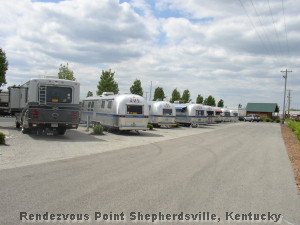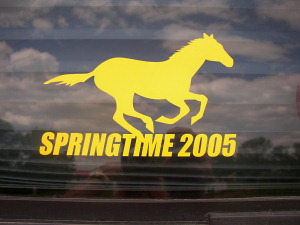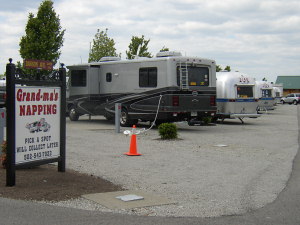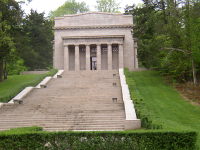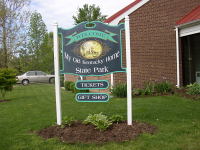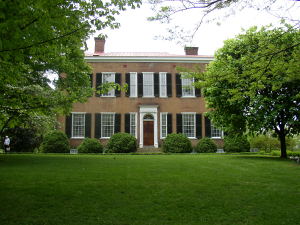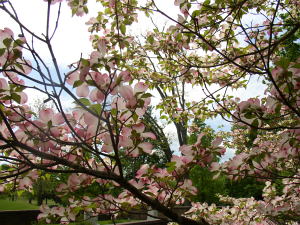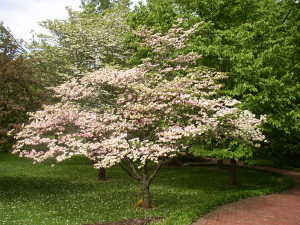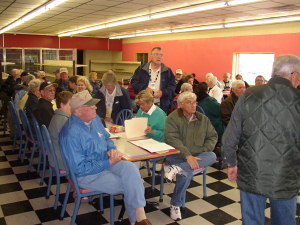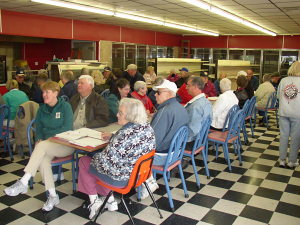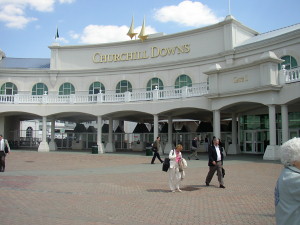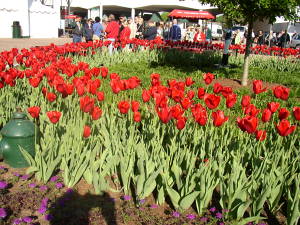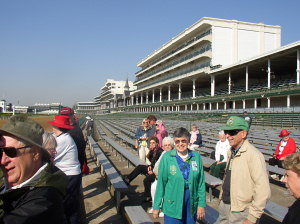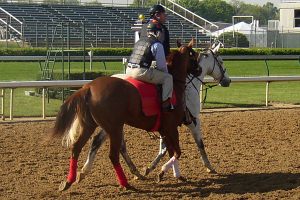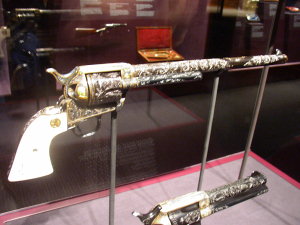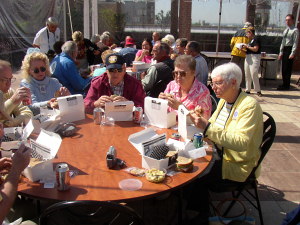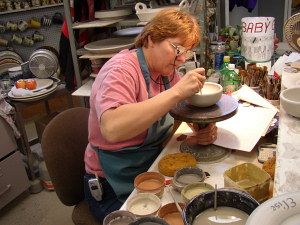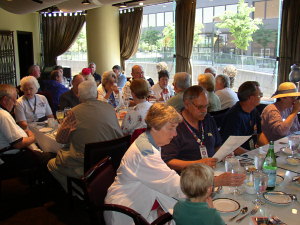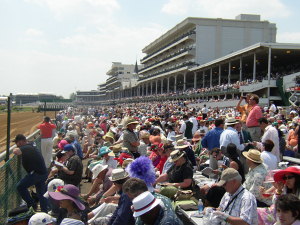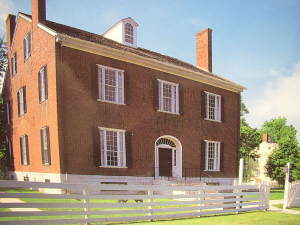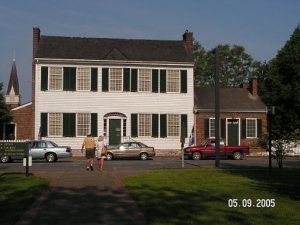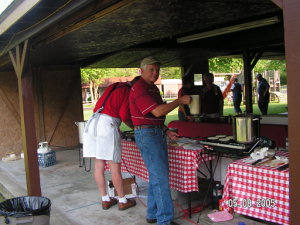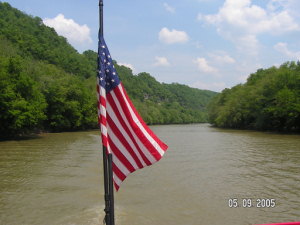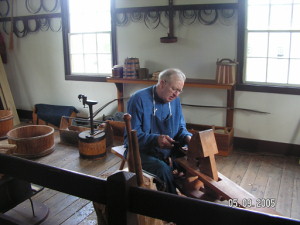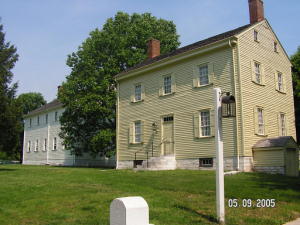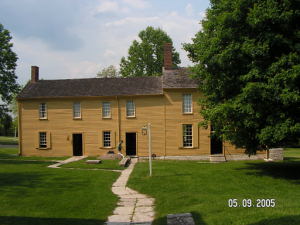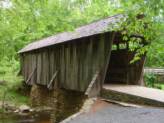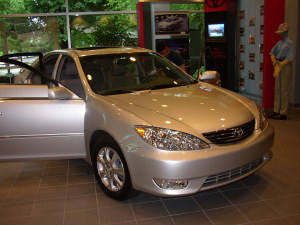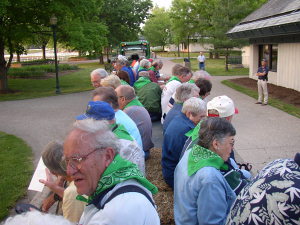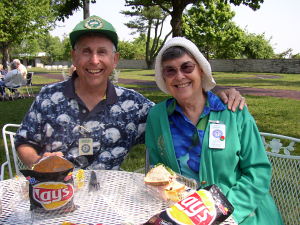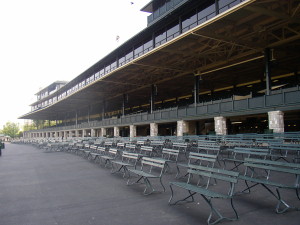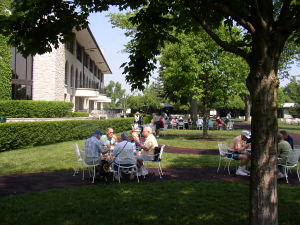The Springtime in Kentucky Caravan of 2005 began on May 2nd as twenty-five Airstream trailers and motorhomes gathered at Grandma's RV Park in Shepherdsville, Kentucky. The weather was nice - cool, but clear. We drove in from Warrenton, Missouri after a week of volunteer work at the Child Evangelism Fellowship headquarters. The trip through busy St.Louis, Missouri, the flat country of central Illinois, and hills of southern Indiana was pleasant with a tail wind most of the way. With fuel prices above $2.00 per gallon, a tail wind helps a bit.
We quickly discovered that there were several couples that we have caravanned with before - Paul and Dot Emmick, Ken and Nancy Davis, Don and Marilee Morris for some. The caravan leaders, Duane and Judy Penner with Clarence and Janice Jones were already in camp to greet folks as they arrived.
Here's a little bit of Kentucky trivia. Kentucky is officially a commonwealth, designated as such in 1792. There are four states carrying that designation. The other three are Pennsylvania, Virginia, and Massachusetts. The state flower of Kentucky is goldenrod. The state tree is the tulip poplar. It is nicknamed the Bluegrass State. The state song is My Old Kentucky Home, written by Stephen Foster. And, Kentucky was the birthplace of Abraham Lincoln.
Monday, May 2, 2005 - The first caravan activity was an icecream social in the campground. It was there that the leaders passed out drivers manuals and set the tone for the caravan. Introductions were made. GAMs (Get Acquainted Meetings) were explained. CB use on Channel 14 was explained. A committee was formed to do a caravan journal. Door prizes furnished by the campground host were drawn for and distributed (we won a gift certificate to Cracker Barrel).
Then came the icecream and cookies.
Louisville is located on the southern bank of the Ohio River, that twisting, curvy river that separates Indiana and Kentucky. Once a major stopover for riverboat traffic, Louisville is a large thriving city with about a million people. This is Derby Week, a week of celebration culminating with the 131st Kentucky Derby horse race at Churchill Downs on Saturday. As we passed through Louisville on the way to the campground in Shepherdsville, we saw hundreds of tents and booths and people taking part in the festivities.
Tuesday, May 3, 2005 - The day began overcast and cool. The skies cleared later, but the wind was brisk and cool all day. At 8:00am we lined up to carpool to the birthplace of Abraham Lincoln. This was the first of several tours of this day. Born near Hodgenville to Tom Lincoln and Nancy Hanks on February 12, 1809, the young Lincoln came into the poor family that was trying to scratch out a living on a 348 acre farm called the Sinking Spring Farm. Tom Lincoln paid $200 for the farm, but due to a flaw in the title, lost it in 1811. So, little Abe lived here only two years and probably remembered very little about the place. Nonetheless, there’s little doubt that the present day inhabitants make a big deal out of their claim to Lincoln fame. Nearly every business in the area makes some reference to Lincoln in its name. The site is a National Historic Site and boasts an elaborate pink marble memorial that protects a replica inside of the cabin of Lincoln’s birth. Maybe the most interesting aspect of the site is the Sinking Spring that served the Lincolns. A paved walkway lined with stonewalls takes visitors down to the spring which still pours out its cold clear water.
Our next stop was at the Old Kentucky Home near Bardstown. This beautiful old home was built in 1795 by a prominent lawyer and judge - John Rowan. The family called the mansion Federal Hill, but when songwriter Stephen Foster visited his cousins in 1852, he immortalized the mansion by writing “My Old Kentucky Home.” The song has since been named as the official state song, and the old Rowan estate is now a Kentucky state park. White and pink dogwoods were in full bloom on the grounds.
In Bardstown we ate lunch at the old Talbott Tavern, one of the oldest building in the city. The tavern was built in 1779 as the western terminal of a stagecoach line from Pennsylvania and Virginia. In the course of its history, it has been called the Hynes House, the Bardstown Hotel, Chapman’s House, Shady Bower Hotel, the Newman House, the Old Stone Tavern, and now Talbott Tavern. Such well known persons as Andrew Jackson, Abraham Lincoln, Stephen Foster, Jesse James, Henry Clay, William Henry Harrison, George Rogers Clark, and even deposed King Louis Phillippe of France have stayed here. The meal was a simple one with Kentucky “burgoo” soup and sandwiches.
The last stop of the day was at the Jim Beam distillery, the largest bourbon distiller in the world. The Beam family has owned the distillery for six generations. The grounds are meticulously groomed. It is obviously a prosperous business.
Back in camp we had our first GAM of the caravan. We hosted one of the gatherings which included Don and Marilee Morris, Charlie and Marge Gutschmidt, Charles and Rita Marcules, and Clarence Jones. Everybody brought snacks and each couple had opportunity to tell more about themselves. Then, at 7:00pm the entire caravan met for a drivers meeting to discuss the next three days activities. Derby tickets were passed out; driving directions were reviewed; upcoming activities were previewed; and betting procedures at the track were explained.
Wednesday, May 4, 2005 - The day began clear, but very cool with frost on the windows of the car. By afternoon it had warmed up nicely. We lined up at 8:15am for another carpool trip - this time into Louisville for a day at the downs. John and Esther Dona from New York rode with us. Churchill Downs is the oldest, continuously operated race track in the United States. Always an impressive place, the recent $121 million renovation makes it awesome. The new Kentucky Derby Museum captures the pride, tradition and excitement of "the greatest two minutes in sports," the Kentucky Derby. The tradition goes back 130 years. The highlight of the museum is a 360 degree high definition video theater which displays highlights of past Derbies and chronicles the life of a racehorse from birth to the winner's circle. After lunch in the new food court, we found our way to our third story box seats to watch the day's races. Tickets for seats like these on derby day would cost over $1,000 and be way out of our reach, but today the crowd was rather thin. Our derby day seats will be open air benches, but really not that bad. We'll then be seated near the starting gate, but will have to watch the finish on the large TV on the infield.
We watched six of the ten races scheduled for this day. Before each race, the horses to run are displayed in the paddock area. They are then led out to the track to the sound of a traditional trumpet call which alerts the fans to the upcoming race. After a few minutes warmup, the horses enter the starting gate, and when the gates open, it takes but two strides for them to get up to 40 mph. Gambling is a complicated process with win, place, and show bets, plus many ways to hedge. Even on a slow day like today, betting averaged over $100,000 per race. Almost everybody was studying their programs and working out their bets.
A humorous event that could have been tragic took place in the 5th race. Shortly after crossing the finish line, one horse abruptly put on brakes, tossing the jockey over his head to the ground. The small jockey got right up, brushed himself off, but then walked sheepishly back to the entrance tunnel. The horse, now free, took off running back around the track, avoiding all attempts to stop him. He disappeared behind some buildings where assumedly he was caught.
The Derby race on Saturday will be the 10th race of the day and will last all of two minutes. There will be 19 or 20 horses in the Derby race - the best of the three year olds. A horse, therefore, has just one shot at the Derby race. Last year's winner - Smarty Jones - is now retired and commanding $100,000 stud fees.
Back in camp we gathered for a mint julep party. Mint juleps, bourbon balls, hot brown, burgroo soup, benedictine dip, and derby pie are all traditional Kentucky fare. A representative from the Buffalo Trail distillery in Frankfort came over and mixed the mint juleps for us. Then she explained the process of making the bourbon that was an ingredient. She explained that bourbon whiskey can only be made in the United States, and that 95% of it was made in Kentucky. Corn is the major ingredient, with wheat, rye, and a few other things mixed in. Then it's stored in new oak barrels to age. The mint juleps were made with a mint flavored syrup mixed into the bourbon. Most comments were that the juleps were very good, but a few said the drink tasted like medicine - green medicine.
Thursday, May 5, 2005 - The day began clear and a little warmer - 40 degrees. We lined up again at 8:00am to carpool to the Frazier Historical Arms Museum in downtown Louisville. An interesting place, the museum is only about a year old. In partnership with Royal Armouries, Britain's oldest museum, Frazier tells the complete story of arms from the Battle of Hastings in 1066 in England to the early 1900s in America. All the spears, bows, knives, swords, rifles and pistols are authentic and are displayed in a manner that tells the history of the two countries. The entire third floor belongs to England and contains items that are the property of England, yet are here on permanent display here. Life size figures through the museum were extraordinarily real looking. The "Beefeater" character pictured at the left here was a dead ringer for the real beefeater that greeted us at the Tower of London several years ago. Live demonstrations took place while we were there also. One dramatized the Battle of Hastings. The other demonstrated the art of using a two-handed sword. The participants were in full period dress - one in chain mail armor.
We spent three hours in the museum, then took an elevator to the roof where we were served an excellent box lunch while enjoying a birdseye view of the Indiana countryside across the Ohio River.
After lunch we drove several blocks to the Louisville Stoneware plant. They produce handmade ceramic pieces of all kinds on a large scale, starting with the raw clay imported from a Pennsylvania coal mine. The clay has to be crushed, then cleaned of unwanted particles, then brought to the right consistency for the plant. Some items are turned while others are cast in molds. Much of their business is personalized items ordered over the Internet, yet they had a full show room of items for sale on the spot.
Some folks stayed in town for the 5:00pm Derby Parade, but we came back to the campground to do some necessary chores - laundry, etc.
Friday, May 6, 2005 - No one knew what we were going to see on this morning, but we formed up in another carpool to make the trip. It was a beautiful day for exploring, and it turned out to be a unique adventure at an old farmstead called Riverside - the farnsley-Moremen Landind. Located on the Ohio River a few miles southwest of Louisville, the old brick home, built in 1837 and still in the process of restoration, gives insight into the way those folks back then lived. It is called the Farnsley-Moremen House, named such because Gabriel Farnsley built it, and the Moremen family who bought it and lived in it for some 100 years. The first floor of the house is being decorated to interpret life in the 1840s, the time period of Farnsley's residence, and the second floor will interpret the 1880s when the Moremens lived there.
The restoration is being conducted very meticulously based on existing records and an ongoing archeological dig. Farnsley was a bachelor who died intestate. The probate records of the fight his family waged for twelve years provide considerable information about the property. Our leaders' son-in-law, Jay Stottman, is the archeologist, and he was there to explain that part of the activity. At one time the farm included 1500 acres, but now is only 300 acres. Standing atop a gentle rise overlooking the Ohio River, the old house commands a beautiful view of the river and the Indiana lands across. The river in the 19th century was that era's super highway. The river not only made for a beautiful setting, but provided an easy way to transport the farm products and other trade goods produced at Riverside. Jefferson County bought the present tract with the house in the early 1990s.
Our next stop was to a bistro in downtown Louisville - Jarfi's Bistro - where we were served hot rolls, hot brown, and Derby pie. The hot brown was like an individual casserole with turkey, ham, bacon, and melted cheese, on toast. Very good. Derby pie is a rich chocolate, walnut cream pie with strawberries and blackberries on the side.
After lunch we walked down Main Street to the bat factory and museum. The Louisville Slugger Museum has the largest baseball bat in the world on display outside their building - about seven stories high (120 feet). It's a Louisville landmark. The Hillerich & Bradsby Company has made the world famous Louisville Slugger bats since 1884. On display were bats swung by legends like Babe Ruth, Ty Cobb, Hank Aaron, and many others. We watched a movie about the operation, then did a walking tour of the plant where an average of 1600 bats are turned out each work day. Most bats are made out of ash lumber, but some players now ask for maple. Once it was a hand turning operation, but now several computerized machines each turn out a bat every minute. Our guide did a good job of describing the process of burning the label and finishing the bat.
Saturday, May 7, 2005 - Derby Day! The Kentucky Derby is the longest running sporting event in the country, drawing people from all over the world. The airport was full of private planes, and a long line of limousines was waiting at the gate to unload their passengers. Officially, there were 156,435 people at the downs, and they have only 55,000 seats. So, over 100,000 people were wandering around the infield, standing at the fences, or participating in parties and ignoring the race. Lines at the wagering windows were long and boisterous. There were long lines at everything - food vendors, port-o-potties, drink stands, etc.
We parked at the fairgrounds, several miles away and took a bus to the downs. Then it was a long, long wait with no place to sit down except at the bleacher seats in the sun. We wandered around under the stands, grabbing a hot dog and a funnel cake and watching the people stream by. Those bleacher seats were the cheap seats - $72 each - and were so far away from the finish line we couldn't hear the speakers or see the TV screens. On the plus side, we were out near the starting gate, so got a great look at the start of the race and at the horses as rounded the last turn.
The worst part of the day came after the race as we had to fight our way out. It took two hours just to get to the buses with pushing and shoving like you wouldn't believe. The facility is just not equipped to handle crowds like this. Finally, we made it back to our car and then home. It had been a long, hard day - nearly ten hours - to watch a two minute horse race. Guess it could be called one of those "been there, done that" deals. Not likely we'd ever want to do it again, but we can now say we've been to the Kentucky Derby - the 131st Kentucky Derby, won by a 50-1 shot horse called Giacomo (Jock'-o-mo).
Sunday, May 8, 2005 - This was moving day, but not before we had our own church service led by Marilee Morris. The move was to Frankfort, Kentucky's capital city, just 70 miles away. We stopped at a Flying J truck stop on the outskirts of Frankfort for long enough to upload this to the web and stall for some time. We were not to arrive at the new campground until 1:30pm. We pulled into the Elkhorn Campground at 2:00pm and were quickly directed to our site. There was another GAM at Helen Griffin's RV. Helen and her sister Ruth were hosts while Carol and George Oelkers were also present. From the GAM we all gathered for a drivers meeting and home cooked meal of beans, burgoo, and corn cakes, topped off with a Mothers Day cake.
Monday, May 9, 2005 - Back to the tours, we headed out to the little town of Danville, Kentucky and the restored home and office of Doctor Ephraim McDowell who practiced frontier medicine in Danville from 1802 until his death in 1830. Dr. McDowell performed the first abdominal surgery, removing an ovarian tumor from a woman who had previously been thought to be pregnant. That story was a stirring one in which the woman - Jane Crawford - had been given no hope of recovery. The operation was performed without anesthesia or antiseptics. It must have been gruesome, but after the 22 pound tumor was removed, Mrs. Crawford recovered quickly and lived for another 30 years. The house is unique. The Pfizer Company has donated a well stocked apothecary shop complete with all the paraphernalia and medicines that would have been available when Dr. McDowell practiced.
Following that tour we drove to Harrodsville and the Pleasant Hill Shaker Village. We did this once before in 1989 and were surprised at the changes. Many more of the buildings have been restored, and there were more people involved in the interpretations. The best of those was a performance by a pleasingly plump black woman who sang several Shaker songs and danced with the movements they would have done. She had a wonderfully clear voice and impressed everyone with her presentation.
We ate in a delightful Shaker dining room in what they called the "Trustees House." It was a typical Shaker meal with turkey, dressing, butterbeans, potatoes, stewed tomatoes, corn sticks, rolls, and lemon or chess pie. We were all doing a little tummy rubbing when it was over.
A paddle wheel boat tour has now been added to the Pleasant Hill experience. The Shakers used the Kentucky River to transport their goods to market. We caught the 2:00pm boat ride which made an hour-long run up the Kentucky River. This is a 250 mile long tributary to the Ohio River - all within the boundaries of Kentucky. The river slices through ancient rock walls which in places, called the palisades, reach upward some 400 feet. There was no other boat traffic on the river and very little development on the shores. The boat was not crowded, and it was a quiet, peaceful excursion through pristine wilderness.
Back on shore we visited several re-enactment scenes: broom making, a cooperage, a laundry, a basket maker, and the animal pens - all done in the style of the Shakers of the early 19th century.
Pleasant Hill, one of nineteen Shaker communities in the United States, began in 1805 and by 1825 was a thriving community with nearly 500 inhabitants, 250 buildings, and 5,000 acres of productive land. They became known as the Shakers because of the charismatic trembling or shaking in their worship services. Because they believed that Christ's second coming had already occurred and that they were living in the promised millenium, they tried to live a life based on separation from the world, communal ownership of property and goods, celibate purity, and confession of sins. They were an industrious people. Their products were of high quality and sold well. Work was divided according to their talents.
With the strict rules on celibacy, it's difficult to understand how they were able to obtain converts, but our guide explained that in that period of history there were a large number of people who were out of work with no place to live. The Shakers, by guaranteeing folks a roof over their heads and a three square meals a day, provided an alternative to poverty. It was that practice of celibacy though that also guaranteed the eventual demise of the Shakers. Their decline started with the Industrial Revolution following the Civil War in the 1860s. With more jobs available, recruitment became difficult. Pleasant Hill was closed in 1910, and the twelve remaining Shakers turned over what was left of their property to a Harrodsville citizen in return for a promise of care until their deaths. The last Pleasant Hill Shaker died in 1923. The other Shaker colonies have all shared the same fate.
The weather was being very kind to us - bright sunny skies and fairly mild temperatures.
Tuesday, May 10, 2005 - We visited the Vietnam War Memorial, Daniel Boone's grave, the Old Capitol building, and the Kentucky History Museum on this day - all locations of interest. Opened in 1988 in honor of the 125,000 Kentuckians who served in the war, the memorial is one of the largest granite memorials in the nation. It contains 215 tons of stone - 327 cut panels. In the center is a stainless steel arm, or gnomon, which casts a shadow on the surrounding stone. Names of those killed in action are engraved in the stone at specific locations so that the shadow of the gnomon touches each name on the date he was killed. The names of the Kentuckians listed as missing in action are etched in an area where the shadow never falls, signifying a continuing vigil. In this way each individual is honored with special tribute. The memorial sits on a hill overlooking the city of Frankfort. It's a soul stirring place.
Daniel Boone's grave and memorial are located on another hill - this one shaded - in the Frankfort Cemetery. This site affords an even greater view of the city. Boone actually died and was first buried in Missouri, but since he spent so much of his life in Kentucky, permission was granted by his family to have his body disinterred and moved to Frankfort. That was in 1840. More recently the people of Missouri have stirred a little controversy about this, claiming that the bones disinterred were really that of another man, and that Daniel Boone's body remains in Missouri. Kentuckians, though, are adamant that such is not the case.
Our next stop was at the Old Capitol building in Frankfort. Three building have been built on this site since Frankfort became the capital in 1793. The first two structures burned to the ground. The present building, designed to resemble a Greek temple, served as the capitol until 1910 when a new, larger building was built about a mile away. One of the more dramatic features of the older building is a circular stone staircase that seems to hang in space without support. Each step fits precisely into the one above it, and it is all held together by the weight of a keystone landing on the second floor level.
We had a guided tour of the Old Capitol, led by a gentleman who was obviously well versed in the history of the building. We visited the old Senate chamber, the chamber used by the House of Representatives, the library, and several other historic rooms. Much effort is being made to refurbish the old building to make it look like it did in 1850. Many of the paintings on the walls have darkened or been damaged, and they too are now being restored.
Just down the street from the Old Capitol is the Kentucky History Center. This modern museum, which opened in 1999, houses some 25,000 artifacts, books, manuscripts, maps, and photograhs, all being saved to preserve Kentucky's rich history. Unfortunately, we didn't get to explore this fully. There were several hundred loud and rambunctious school children in the museum when we were there. It was obvious though that this was a special place.
After lunch we drove out to an old wooden, covered bridge - the Switzer Covered Bridge. The bridge is designated as the official covered bridge of the Commonwealth of Kentucky. It is no longer open to car traffic, but we were able to walk across it and take some pictures. The 100 foot long bridge spans Elkhorn Creek - only about 5 miles from our campground, the Elkhorn Campground.
Wednesday, May 11, 2005 - Four more tours this day: Rebecca Ruth Candies, the Governors Mansion, the New Capitol, and the Buffalo Trace distillery. The candy factory, begun during Prohibition by two sisters, Ruth and Rebecca, struggled for years before the idea of adding Bourbon to the mix came along. Then business mushroomed. It's quite a success story for two women in the early 1900s. The factory is in a residential neighborhood and looks just like another house from the front, but an add-on to the rear gives it more room than would first appear. They guard their formula and production secrets fiercely, but we did get to walk through the processing area. There is a mixing room, then an extrusion machine that pumps out eight candies onto a belt tht runs through a chocolate bath. Workers then place a pecan half on each piece as it goes by on a conveyor. The candies are then packed into boxes by hand. It's a small operation, but it puts out over 100,000 pounds of candy each year - and they are good!
It was just a short distance from Rebecca Ruth Candies to the new Capitol building and Governor's Mansion. The lady who guided our tour of the mansion was excellent, and that residence is really a palace - patterned after a palace in France. Everything was meticulously decorated - beautiful furniture, paintings, drapery, and carpets. Their flower arrangements were a little on the wilted side. They had been fresh for Derby day, and were due for replacement. We even got to meet the first lady of Kentucky, the governor's wife.
Then we walked over to the new Capitol building - new because it's newer than the old Capitol building, but it's been there since 1910. Of all the state capitol buildings we've seen, this one is the most magnificent. Constructed of marble from Georgia, Tennessee, Vermont, and Italy, it rivals, and may even be more ornate and majestic than the capitol building in Washington DC. The rotunda features statues of Abraham Lincoln, Henry Clay, Alben Barkley, Dr. Ephraim McDowell, and Jefferson Davis - all with special ties to Kentucky. The first floor houses the executive branch offices, the state supreme court and attendant offices are on the second floor, and the legislative branch occupies the third floor. We toured each of those floors with a young lady who did herself proud.
Then, many of the caravanners drove to Jim's Seafood House on the Kentucky River for lunch before the final tour of the day - the Buffalo Trace distillery. We were impressed with the extreme care that goes into the production of Bourbon whiskey. When they fill a new oak barrel with freshly distilled whiskey, it loses 10 to 12 percent of its volume the first year, soaking into the barrel and another 2 - 3 percent each year thereafter from evaporation. Specific brands require specific aging times. The longer the aging (and some stay in the barrels for 23 years) the higher the cost and the finer the whiskey. Most of their bottling is done from the 9 year batches. One reason why this area of Kentucky has so many distilleries is because of the calcium content of the water here. It somehow reacts with the yeast and speeds up fermentation. Buffalo Trace is the oldest continuously run distillery in Kentucky, beginning in 1787. That statement triggered the question about how they continued to operate during prohibition. They stayed open by filling prescriptions for medicinal whiskey. There must have been a lot of prescriptions written by doctors during prohibition. It was an interesting tour, but couldn't help but think of all the headaches and other problems the whiskey represents.
We had our fourth GAM at the Emmicks RV. Dave and Lori Martin, Nancy and Harold Skinner, Mary Ann and John Johnson, Ann and I, with Paul and Dot Emmick as hosts were present. We took turns telling of our favorite Airstream adventures. Then to finish off a very busy day, we had ice cream and a drivers meeting at 7:00pm.
Thursday, May 12, 2005 - This was moving day - this time to Lexington and the Kentucky Horse Park Campground, just 30 miles from Frankfort. Most of us got into camp by 10:30am and had a couple hours of free time. The Kentucky Horse Park is a 1200 acre park dedicated to introduce visitors to the horse. It's home to about 50 different breeds at work and at play. It's a real working horse farm, home to many retired champions.
Our first activity had nothing to do with horses however. In early afternoon we lined up in carpool to visit the Toyota manufacturing plant in nearby Georgetown. What a massive facility that is! They put out over 2,000 cars each day - Camrys, Solaras, and Avalons. The plant was built in 1988, but certainly appears to still be on the cutting edge of automation. Huge reels of sheet steel come in on semi-trucks, the sheets are stamped into proper shape, welded together and painted, engines are made in one building, plastics are extruded in another, other parts are purchased, and it all comes together in the assembly area. It's not completely automatic. More than 7,000 employees work on the lines in buildings that cover 7.5 million square feet.
The tour was innovative too. We were each given a pair of safety glasses and a set of earphones. We were then assigned to a guide who led us into the plant and to a tram station. Each tram held 16 people in comfortable seats. Once strapped in, the guide kept up a running commentary on the various lines we were watching. It was all very impressive and left us with a good feeling about the quality of the Toyota vehicles made here. In addition to the visitor trams, there were trams carrying parts from one part of the plant to another. There were employees riding ordinary tricycles around. There were unmanned robots moving about the aisles. There were other vehicles continually cleaning the floors. And a few people were merely walking about. It took an elaborate system of signals and signs to control all this traffic. It was noisy, but the earphones made it possible to hear the guide, no problem.
That evening we enjoyed a relaxing hay ride from the campground to the horse park. It was two wagons pulled by a big John Deere tractor. The 30 minute ride took a round about way through some beautiful rolling pasture land. Then, we were granted access to the museum which is a magnificent display of anything and everything to do with horses. It was like a private showing since the museum was closed to everyone else. Then we had a nice buffet dinner in the Clubhouse restaurant, followed by a clogging group that entertained for a half hour. It was almost 9:00pm before we arrived back on the hay ride home.
Friday, May 13, 2005 - This was one of those days where the weather cooperated despite dire forecasts by the TV weathermen. We left camp early for the short drive to Keeneland, one of the finest and most beautiful racing facilities in the world. The route took us through some very nice blue grass countryside. Locust trees were in full bloom, adding more beauty to the fenced bluegrass pastures.
The mile and a quarter race track at Keeneland is immaculately groomed, and the viewing stands are excellent, though considerably smaller than Churchill Downs. A big crowd at Keeneland would be 35,000. They do much more at Keeneland than hold racing events. The racing only takes place during April and October - just two months. The rest of the year is devoted to training horses, auctions, and special events like steeplechases and harness racing. The buildings are all stone with vines growing up the walls. Our guide spent over an hour explaining it all and taking us up to the highest level of seating. Horses were being exercised on the track - some running at full speed, others just trotting. This all stopped at 10:00am, so the track could be re-groomed.
One unusual event which drew 31,000 people to Keeneland this year was the simulcasting of the Kentucky Derby. Many people from Louisville chose to come to Keeneland to watch the Derby in comfort. Large TV screens were set up in the infield, the scoreboard was activated, the loudspeakers carried the same announcer as at Churchill Downs, and all the wagering windows were open and functioning. There's none of the wildness that goes on at Churchill Downs.
We gathered for a catered picnic lunch in a beautiful courtyard area, living it up like the elite. Just one other group was there for a tour, so we had the place pretty much to ourselves.
One of the surprising things about Keeneland was that the admission price for the events is extremely reasonable. They charge $3.00 per person which includes parking. Reservations have to be made well in advance though, and there is a dress code. Men have to be in coat and tie. Women in appropriate length dresses. Keeneland occupies 992 acres of rolling Kentucky bluegrass country - land which was granted to the Keene family by Patrick Henry back in 1788 when he was governor of Virginia and this area was a still a part of Virginia.
After lunch we drove over to the Three Chimneys Farm - the retirement home of Smarty Jones, last year's Derby winner. It was also the retirement home of Seattle Slew until he died. Retirement home is not a good description because these beautiful horses are being used to sire expensive offspring. Smarty Jones commands a $100,000 stud fee and stays busy - sometimes working three times a day. Owners from all over the country bring their brood mares to Three Chimneys for breeding. These are carefully controlled events that are recorded on video tape in a specially designed, round, padded building. I won't try to describe the mating we witnessed other than to say it was interesting. It will not be included in my caravan video.
Three Chimneys Farm is but one of over 400 Thoroughbred farms in Kentucky. Raising these beautiful horses is big business with millions of dollars changing hands annually. A colt with a good pedigree could sell for over a million dollars - the purchaser taking the calculated risk that a good bloodline will produce a good racehorse. Many of the descendants of the champions have been champions themselves, but there's no guarantee. Three Chimneys is obviously very successful in their handling of champions. Their income comes from boarding fees, a percentage of the stud fee, and a percentage of the sales price when the foal of a boarded mare is sold. They also provide the services of a pedigree specialist - for a fee - whose expertise is in optimizing the matching of bloodlines.
Saturday, May 14, 2005 - This was a free day to relax and get caught up on the necessaries like laundry. A light shower cooled things off early, and it rained intermittently all day. Some folks went one way, ane some went another. We went over to Georgetown and drove up and down Main Street, looking at a number of large, old homes. We had lunch at the Lock & Key Coffee Shop which was located inside an old bank lobby. It was a free Wi-fi hotspot, so we had a chance to upload these notes and get our email.
Later in the day we met under a sheltered picnic area in the campground for our last GAM and a drivers meeting. At this GAM we met with Gordon and Marie Syrett, Dan and Emily Neumarkel with their grandson Johnny, Ken and Phyllis Lowe, and Anna Janesko.
